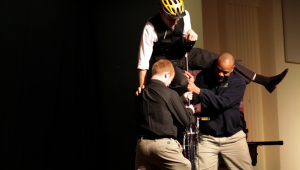
For many variety performers out there, one of the challenges is filling a 45-minute window of time with engaging content for hundreds or thousands of people. Since I work mostly with audiences that include lots of kids, I have found 45 minutes tends to be a good length of time for family audiences to enjoy a show by a single performer.
But the performance has to be good in order to entertain a crowd for that long. And the younger the audience member, the shorter the attention span. As a stage performer, I can hold the focus of a group of 2-3 year olds for maybe 20 minutes if I’m doing well. But ages 4 and up can usually enjoy a full 45 minutes, and then they start to fade no matter how good you are.
I have spent the past 14 years putting together performance sets using a variety of performing arts. So here are ten things I’ve learned over the years about how to put together quality content for a 45-minute stage show:
- Strong Opening and Strong Closing – make the first and last tricks some of your strongest. You have about 3 seconds to make a good first impression to your audience when you appear, so bring out one of your best tricks at the beginning. Then close the act with something just as strong, if not, stronger. Thanks to Bob Cates who told me this tip.
- Short Sets – I have about 10 different tricks/stunts/routines that I perform in a 45-minute set. That’s an average of 4-5 minutes per routine. Some of my tricks take only 2 minutes, some take 8, but most are in the 3-6 minute range. Keep each bit short and exciting and then quickly move on to the next routine.
- Smooth Transitions – speaking of quickly moving from trick to trick, try to have a smooth transition from one to the other. Know exactly what order your tricks are in and have a set list written out on a piece of paper on the floor or in your prop box. You can lose the momentum of your show if you spend too much time looking around for what’s next. If the transition takes a few extra seconds, call up a volunteer (to do anything) and make your transition moves while they’re coming up on stage.
- Volunteers – speaking of volunteers, use LOTS of them. This is one of the secrets of good performing that I learned early on. The audience feels more connected to you if you involve them somehow. One of the best ways to involve them is to invite normal people from the crowd to help you and assist you. Not everyone has to come on stage. Just having a volunteer up there makes someone else in the audience think,”that could be me,” and that includes everyone in your show in a special way. In another blog post, I have written ten commandments about how to use and treat volunteers in your show.
- Stage Presence – this goes for any kind of performing, acting, dancing, public speaking, etc. Be awake, alive, energetic, and SMILE. Because you are so small on a big stage, the audience cannot read normal one-on-one mannerisms. So everything you do has to be bigger, from your smile to your movements to your facial expressions.
- Patter – speaking of stage presence, a major part of your show is what you say. Unless you are Anthony Gatto (or a really good mime), your juggling/magic/variety skills will only entertain without words for a short period of time. If you want to fill 45 minutes with quality content, then you should have some good “patter” lines, which are things you say during and in between tricks. This is where the audience connects with you. They see you as a real person, and the things you say will make them laugh. And quite honestly, most of your audience wants to laugh more than they want to see you do a spectacular trick. The more shows you do, the more lines you will develop as your own. I have said many things that make the crowd laugh and many things that fall totally flat. I never knew which lines would lead to which response until I tried them (or accidentally said them). I simply keep the lines that lead to a positive response and ditch the lines that fall flat. The best way to develop this is to just go out and do tons of shows for whoever will watch for any amount of money (as low as nothing). I did hundreds of volunteer shows for the first 4 years of performing (it was a side gig). And then that eventually turned into a full-time career because I had lots of practice and I enjoyed it so much.
- Tricks and Routines – write out on a notepad ALL your tricks and routines. Then find about 10-15 of your favorite ones and put them in an order for a 45-minute show. Write out the details of each trick (such as props needed, music needed, volunteers needed, patter lines, etc.) and then perform the show with that piece of paper near you on stage for quick reference. I always have a set list on stage with me. I rarely look at it. Sometimes I do the whole show without looking at it at all. But I still go through the process of writing out a set list for every single show I do. That helps me mentally prepare for the order and the special nuances of that particular crowd and venue.
- Music – speaking of music, it really helps to have good background music for your routines. Make sure the volume is loud when you want it loud and soft enough when you want to talk over it. I have an iPod with with my song list on stage with me. That way, I can control the volume of the music from the stage. You need a direct box on stage plugged into a sound channel and then a cord to go from the direct box to your iPod or MP3 player (usually 1/4-inch male to 1/8-inch male).
- Feedback – your 45-minute show can really improve when you get honest feedback from people who see your show – including yourself. If you get a video of your show, watch it and scrutinize yourself. Have peers watch the show with the intention of getting honest feedback from them (thanks for that tip, David Cain). Get your hosts to fill out an evaluation sheet after your show. That way you can improve on the things they saw as needing improvement and you can use their positive feedback as quotes and references for future gig opportunities. Don’t be afraid of feedback. Most people will love your show. And take the constructive criticism as an opportunity to grow.
- Just Do It – just go out and do as many shows as you can. The best way to develop a good 45-minute show is by lots and lots of practice – both by yourself and in front of audiences.




7 responses to “Developing a 45-minute Show”
Great article. May I submit it to FCM to reprint in their magazine?
Gary
What kind of music would you suggest for juggling shows? Specifically songs and artist that you usually use. Thanks!
– David
Hi David, thanks for your question. I suggest using royalty free music that is in the public domain. That is because you are using music in a live performance that you are getting paid for. If you’re not getting paid for the show, then use whatever you like. I recommend musopen.org (I like the circus sounding marches by Sousa or Berlioz). I also use a Beethoven piece from there as well. You can also try freepd.com. I like the song “Connection” by Brian Boyko. It works well with juggling in my opinion. I have also recorded some stuff of my own on GarageBand, which is something worth trying if you’re into making music and recording.
Great Article,
Also great resources on the music you listed in the comments. I did not know about those sites. Also check out freeplaymusic.com
Re: VOLUNTEERS.
You mention use LOTS of them. I would say that depends: I performed for many years on Holland America Cruise line, which is a mostly older/seniors cruise line. My 50 minute show, while *interacting* with lots of people from stage via both comedy and physical prop toss-ins, I only had 1 volunteer actually come on stage the entire show. With such an older crowd it would have been tough to get a lot of people to come to the stage in a timely fashion (not to mention even want to).
My wife is a bit more reserved, wishing that many performers would rely less on volunteers.
Personally, I try to make sure that I *generally* alternate routines: one without a volunteer, and one with. Or to put it another way, I try not to do two routines in a row where I have to go and find someone in the audience.
For a juggling act, I realize I may be in the minority in this opinion though.
Bob 🙂
Thanks, Bob. I’ll check out that website. The volunteer thing definitely changes with the audience demographics. The “LOTS” of volunteers works with kid-heavy crowds, which is the majority of my shows. When I do older crowds, the number of volunteers that want to come up tapers down as average age increases. And with your experience, you would know what works with those crowds, so thanks for the input!
Now, if I could just come up with a show that is done entirely by volunteers, that would be great. I could just sit back and watch for a change. lol
ha! 🙂